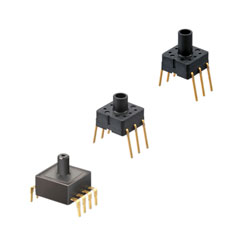Panasonic Automotive Systems introduced a series of high-precision, miniature semiconductor pressure sensors. They have built-in amplifier and temperature compensation circuits (PS-A unit). Precision sensors without amplifiers and Wheatstone measurement bridges are also available, and are available in ultra-small size (PS). There are also versions with chamfered pins to improve the ease of inserting the DIP pins into the PCB.
There are three types of PS-A units. Standard models with a glass base can withstand pressures from ± 100kPa to -1000kPa, with a total accuracy of ± 1.25%. The economical version without glass base is suitable for 40kPa pressure and ± 4% accuracy, while the low-pressure model is suitable for 6kPa and ± 2.5% accuracy. The footprint is 7mm x 7.2mm (low pressure type is 10.4mm x 10.4mm).
Alexander Hoch, Panasonic Product Marketing Team Leader, said: "PS-A units can be used for pressure switches and pneumatic devices in industrial applications: they also have medical uses for sphygmomanometers, compressed air pressure measurement and air Beds and other pneumatic pressure equipment. Low pressure types can be used for water level detection in domestic washing machines and dishwashers, air pressure control in clean rooms, and medical breathing pressure measuring instruments. "
PS and PF sensors are available in two versions. Standard models with a glass base can withstand pressures from 4.9 to 980.7 kPa, and economical models without a glass base can withstand 40 kPa. Used with standard 5kohm bridge resistor models is a PS device with a 3.3kΩ resistor, which is best suited for 5V drive circuits. The company says applications for PS devices include industrial pressure switches and pneumatic devices, as well as medical blood pressure measurement.
"In the PS version, high precision and linear detector response have been achieved through the application of a semiconductor strain gauge system," Hoch added. "This makes them highly reproducible under repeated pressure."
